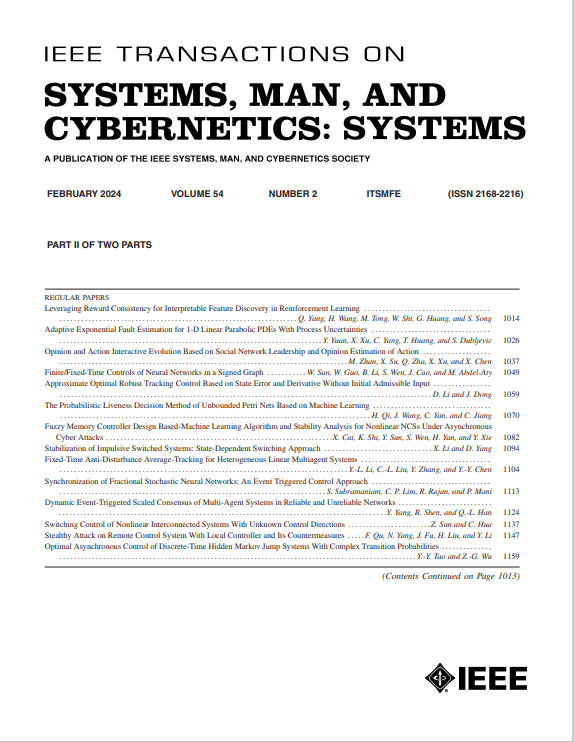约束通信拓扑下多自治追随者的人类领导行为学习
IF 8.6
1区 计算机科学
Q1 AUTOMATION & CONTROL SYSTEMS
IEEE Transactions on Systems Man Cybernetics-Systems
Pub Date : 2025-04-25
DOI:10.1109/TSMC.2025.3560325
引用次数: 0
摘要
由于当前人工智能技术的不成熟,实际的多智能体系统(MASs)往往需要人类的监督和干预。然而,在某些情况下,人类监控整个MAS并提供适当的输入是不现实的。一个可行的方法是允许人类控制一个作为领导者的代理,从而影响其他自主的追随者。为此,一个关键的问题是如何学习人类的行为,以提高追随者的自主性,以便有效地与人类合作,因为自主追随者没有人类行为的先验知识。本文研究了一类非完全连接的人在环(HiTL)群的人类领导行为学习问题。应用线性二次微分对策框架来制定HiTL MAS中的协同控制问题,其中人类行为被表示为一个代价函数,其权重矩阵对追随者是未知的。在HiTL MAS中,我们选择一个具有强大计算能力的追随者,称为追随者1,通过在线自适应逆微分博弈(IDG)方法学习人类行为。基于并发学习(CL)技术,建立了追随者1在线确定人反馈矩阵的自适应律,同时在约束通信拓扑下,由追随者1计算自治追随者的交互策略。随后,通过求解线性矩阵不等式(LMI)优化问题,恢复了人力成本函数中的权重矩阵。最后,通过数值算例验证了该方法的有效性。本文章由计算机程序翻译,如有差异,请以英文原文为准。
Human Leading Behavior Learning for Multiple Autonomous Followers Under Constrained Communication Topologies
Owing to the immaturity of current artificial intelligence techniques, practical multiagent systems (MASs) often require supervision and intervention from humans. However, it is unrealistic for a human to monitor the entire MAS and provide appropriate input in some circumstances. A viable approach is to allow a human to control an agent as the leader which in turn influences the other autonomous followers. To this end, a critical issue is how to learn human behavior to improve the autonomy of followers for collaborating with human effectively, since the autonomous followers do not have prior knowledge of human behavior. In this article, the human leading behavior learning problem is studied for a class of human-in-the-loop (HiTL) MASs that are not fully connected. A linear quadratic differential game framework is applied to formulate the collaborative control problem in the HiTL MAS where the human behavior is represented as a cost function whose weighting matrix is unknown to the followers. In the HiTL MAS, we select a follower that has strong computing power called follower 1 to learn the human behavior via an online adaptive inverse differential game (IDG) approach. Based on concurrent learning (CL) technique, an adaptive law is developed for follower 1 to determine the human feedback matrix online, and at the same time the interaction strategies for the autonomous followers are also calculated by follower 1 in case of the constrained communication topology. Subsequently, the weighting matrix in the human cost function is recovered by addressing a linear matrix inequality (LMI) optimization problem. Finally, a numerical example is presented to demonstrate the effectiveness of the proposed method.
求助全文
通过发布文献求助,成功后即可免费获取论文全文。
去求助
来源期刊

IEEE Transactions on Systems Man Cybernetics-Systems
AUTOMATION & CONTROL SYSTEMS-COMPUTER SCIENCE, CYBERNETICS
CiteScore
18.50
自引率
11.50%
发文量
812
审稿时长
6 months
期刊介绍:
The IEEE Transactions on Systems, Man, and Cybernetics: Systems encompasses the fields of systems engineering, covering issue formulation, analysis, and modeling throughout the systems engineering lifecycle phases. It addresses decision-making, issue interpretation, systems management, processes, and various methods such as optimization, modeling, and simulation in the development and deployment of large systems.
 求助内容:
求助内容: 应助结果提醒方式:
应助结果提醒方式:


